Austrian film and stage actor Gustav Diessl (1899-1948) was the hero of the first Mountain film, Die weiße Hölle vom Piz Palü (1929). This film and others by prolific director G.W. Pabst made him at the time an unusual sex symbol: the mature, quiet, somewhat difficult man who attracts women almost against his will. Under the Nazi regime, he was often cast as an exotic villain or a mysterious foreigner.
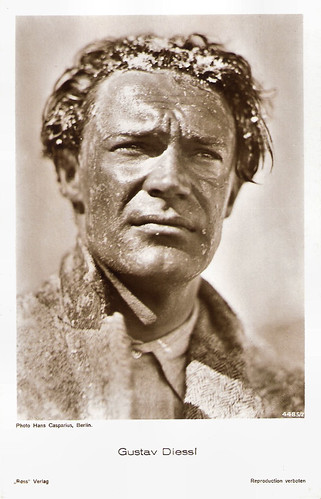
German postcard by Ross Verlag, no. 4485/2, 1929-1930. Photo: Hans Casparius, Berlin. Publicity still for Die weiße Hölle vom Piz Palü/The White Hell of Pitz Palu (Arnold Fanck, G.W. Pabst, 1929).

German postcard by Ross Verlag, no. 5385/1, 1930-1931. Photo: Aafa-Film. Gustav Diessl and Mady Christians in Leutnant warst Du einst bei deinen Husaren/Lieutenant were you once with your Hussar (Manfred Noa, 1930).
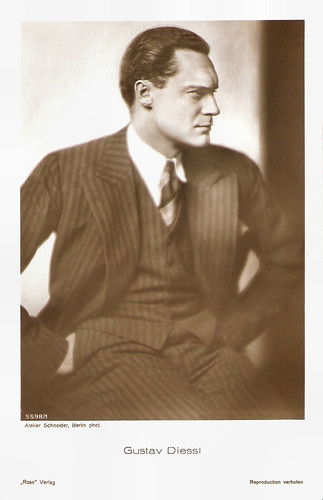
German postcard by Ross Verlag, no. 5598/1, 1930-1931. Photo: Atelier Schneider, Berlin.
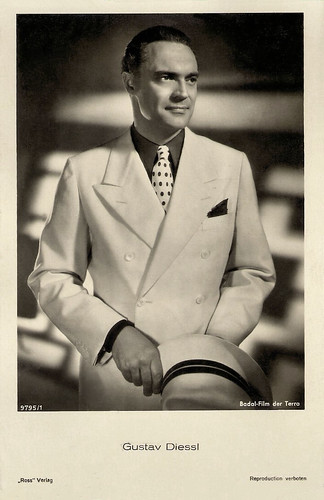
German postcard by Ross Verlag, no. 9795/1, 1935-1936. Photo: Bodal Film der Terra.
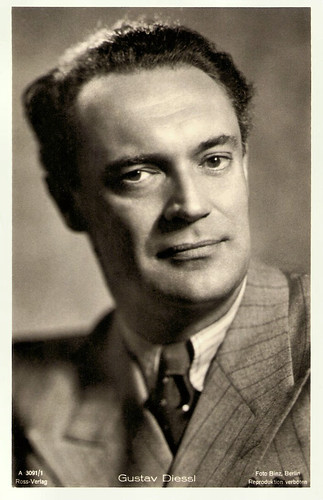
German postcard by Ross Verlag, no. A 3091/1, 1941-1944. Photo: Binz, Berlin.
Gustav Diessl was born Gustav Karl Balthasar in Vienna, Austria-Hungary (now Austria). He was the son of a classical scholar and studied art, painting and sculpture at the Kunstgewerbeschule (art school) in Vienna. In 1916, he worked as an extra on different stages in Vienna but he was soon recruited into the army for World War I. During his military service, he was held prisoner for a year. After the war, Diessl started training as a stage designer but he left to pursue a professional acting career. He played for a touring company and in 1921 had his first fixed engagement at the Neue Wiener Bühne (New Viennese Stage). That same year he appeared in his film debut In Banne der Kralle/In the Spell of the Claw (Carl Froelich, 1921).
The next years he made several films, including the silent films Vineta (Werner Funck, 1923) with Evi Eva, the Austrian-Polish co-production Ssanin/Sanin (Friedrich Feher, Boris Nevolin, 1924) starring Magda Sonja, and Die Rache der Pharaonen/The revenge of the Pharaohs (Hans Theyer, 1924) with Suzy Vernon.
He moved to Berlin where he worked with the prolific director Georg Wilhelm Pabst on Abgründe/Crisis (G. W. Pabst, 1928) opposite Brigitte Helm, and a year later he played Jack the Ripper in Die Büchse der Pandora/Pandora's Box (G. W. Pabst, 1929) with Louise Brooks. That same year he had his breakthrough with Die weiße Hölle vom Piz Palü/The White Hell of Pitz Palu (Arnold Fanck, G.W. Pabst, 1929) opposite Leni Riefenstahl. It was the first Mountain film, a genre that became very popular in Germany.
Diessl was now a huge star with an unusual kind of sex appeal. He was the prototype of the mature, quiet, somewhat difficult man who attracts women almost against his will. Very popular was Die Drei um Edith/Three around Edith (Erich Waschneck, 1929) in which he starred opposite Camilla Horn and Jack Trevor.
His first German sound film was the anti-war drama Westfront 1918 (G.W. Pabst, 1930) with Fritz Kampers. In the meantime, Die weiße Hölle vom Piz Palü had made Diessl also famous in the US and he had received an invitation by MGM to come to work in Hollywood.
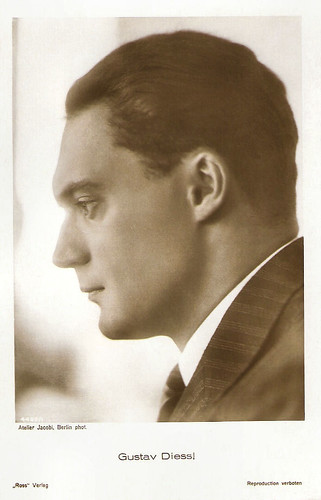
German postcard by Ross Verlag, no. 4485/1, 1929-1930. Photo: Atelier Jacobi, Berlin.
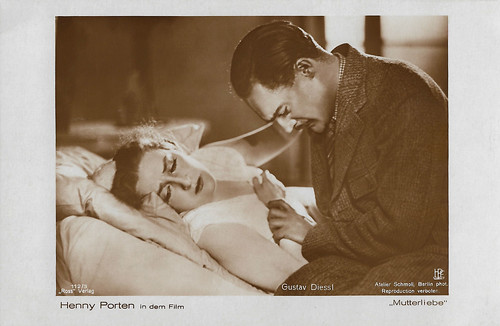
German postcard by Ross Verlag, no. 112/3. Photo: Atelier Schmoll, Berlin / Henny Porten-Film Produktion. With Henny Porten in Mutterliebe/A Mother's Love (Georg Jacoby, 1929).
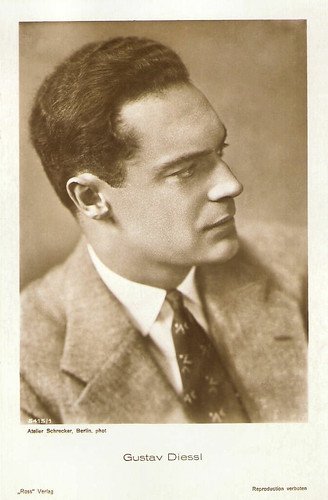
German postcard by Ross Verlag, no. 5450/1, 1930-1931. Photo: Atelier Schrecker, Berlin.
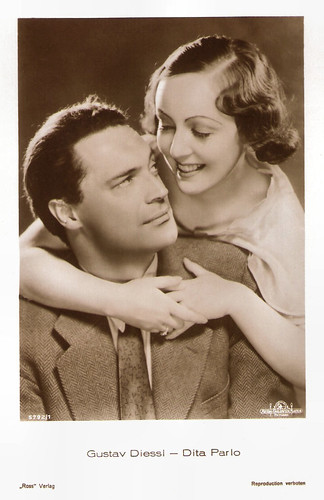
German postcard by Ross Verlag, no. 5792/1, 1930-1931. Photo: Metro-Goldwyn-Mayer. Publicity still for Menschen hinter Gittern (Pál Fejös, 1930) with Dita Parlo. This was the German language version of The Big House (1930). Pál Fejös or Paul Fejos was a Hungarian-born, multi-lingual director, who worked at MGM at the time. He was assigned to direct both German- and French-language 'parallel versions' of The Big House, using different actors but the same costumes and sets at MGM.
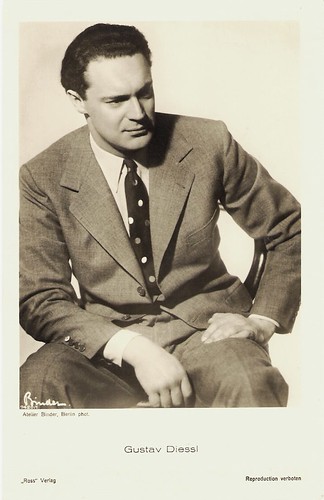
German postcard by Ross Verlag, no. 7420/1, 1932-1933. Photo: Atelier Binder, Berlin.
After making only one American film, Menschen hinter Gittern/Men Behind Bars (Pál Fejös, 1931) – the German language version of The Big House (George W. Hill, 1930), with Heinrich George in Wallace Beery's role, Gustav Diessl returned to Germany. He immediately started working again.
He appeared in such early sound films as Hans in allen Gassen/Hans in All Alleys (Carl Froelich, 1930) with Hans Albers, the French Paramount production Les nuits de Port Said/The Nights of Port Said (Leo Mittler, 1932), and the fantasy film Die Herrin von Atlantis/Mistress of Atlantis (G.W. Pabst, 1932), in which he was the only colonial soldier who could resist the temptations of the seductive mistress of the title, played by Brigitte Helm.
The adventure film S.O.S. Eisberg/SOS Iceberg (Arnold Fanck, 1933), starring Diessl and Riefenstahl again, and the mountain film Weiße Majestät/White Majesty (August Kern, Anton Kutter, 1933) with Hertha Thiele, tried to continue the success of Die weiße Hölle vom Piz Palü/The White Hell of Piz Palu. During the 1930s, Diessl remained in demand as a sinister villain or difficult-to-cast foreigner. Already in 1931, he had portrayed a demonic Chinese villain in the exotic drama Das gelbe Haus des King-Fu/The Yellow House of King-Fu (Karl Grune, 1931), and he had played a gangster in the highly successful Das Testament des Dr. Mabuse/The Testament of Dr. Mabuse (Fritz Lang, 1933) featuring Rudolf Klein-Rogge.
In the Nazi era, he was shown more frequently as a foreigner. First, he appeared in the German-Italian co-production Die Liebe des Maharadscha/The Love of the Maharajah (Arthur Maria Rabenalt, 1936) as an exiled Maharajah, who falls for a piano player (Italian diva Isa Miranda) because she resembles his deceased wife. That same year, Diessl joined the melodrama Der Weg nach Shanghai/Moscow Shanghai (Paul Wegener, 1936) as a Russian captain, who in the revolutionary turmoil fell in love with a beautiful singer (Pola Negri). He again played a Russian in the revolution melodrama Starke Herzen/Strong Hearts (Herbert Maisch, 1937).
Then he appeared as an adventurer who falls in love with the wife of a Maharajah (La Jana) in the exotic two-parter, Der Tiger von Eschnapur/The Tiger of Eschnapur (Richard Eichberg, 1938) and Das indische Grabmal/The Indian Tomb (Richard Eichberg, 1938). In 1940, he played a rich Brazilian, again opposite La Jana, in the crime film Stern von Rio/Star of Rio (Karl Anton, 1940).
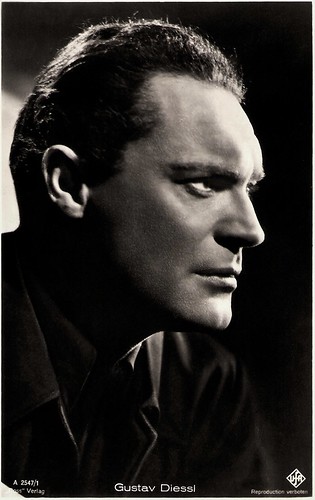
German postcard by Ross Verlag, no. A 2547/1, 1939-1940. Photo: Ufa.

German postcard by Ross Verlag, no. A 2804/1, 1939-1940. Photo: Wog, Berlin. Gustav Diessl and Maria Cebotari.
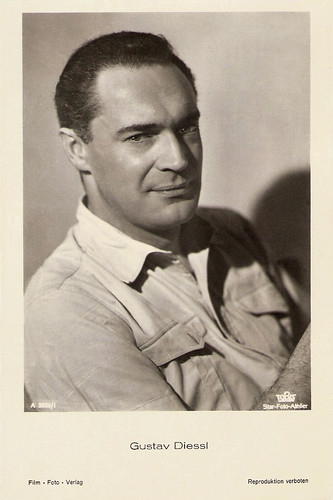
German postcard by Film-Foto-Verlag, no. A 3909/1, 1941-1944. Photo: Star-Foto Atelier / Tobis.
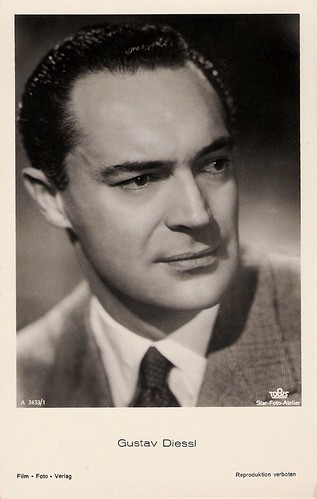
German postcard by Film-Foto-Verlag, no. A 3433/1, 1941-1944. Photo: Star-Foto Atelier / Tobis.
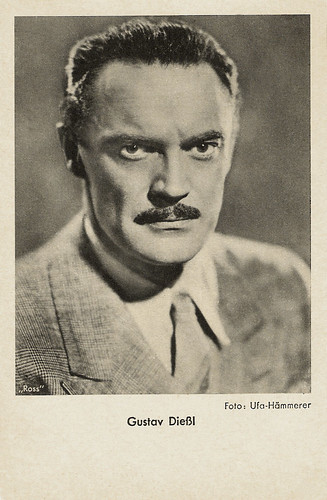
German postcard by Das Programm von Heute, Berlin / Ross Verlag. Photo: Ufa / Hämmerer.
After his first short-lived marriage with Irmgard Amalie Wettach had ended, Gustav Diessl lived with actress Camilla Horn for a couple of years. In 1937, during the filming of Starke Herzen/Strong Hearts, he met the famous opera singer and actress Maria Cebotari. They fell in love and because of him, Cebatori got divorced. They married in 1938 and stayed together for the rest of his life.
During the 1940s, Diessl knew to remain popular, and he played in such films as Komödianten/The Comedians (Georg Wilhelm Pabst, 1941), and the anti-Slovenian Propaganda film Menschen im Sturm/People in the Storm (Fritz Peter Buch, 1941) with Olga Tschechova. Between 1940 and 1944, he worked almost exclusively in Italy. He appeared in such films as Senza cielo/Without Sky (Alfredo Guarini, 1940) with Isa Miranda, La donna del peccato/The Woman of the Sin (Harry Hasso, 1942) with Viveca Lindfors, and Maria Malibran (Guido Brignone, 1943) featuring Cebotari.
In 1944 he made again German films such as the Henrik Ibsen adaptation Nora (Harald Braun, 1944) with Luise Ullrich. Diessl’s last film role before the end of the Second World War was that of the Prussian Lieutenant Ferdinand von Schill in Veit Harlan's Kolberg (Veit Harlan, 1944). Diessl appeared in one more film, as a prosecutor in G.W. Pabst's in Austria produced film Der Prozess/The Trial (G.W. Pabst, 1948) about anti-Semitism. Shortly after making this film, Gustav Diessl suddenly had two strokes.
Diessl, who was only 49, passed away in his hometown Vienna. Maria Cebotari died only one year later of liver cancer. They had two sons, who were adopted by the pianist Clifford Curzon and his wife Lucille Wallace-Curzon. One of Diessl’s sons lives today in England and the other one in New Zealand.
After the death of Diessl, two of his older films finally were shown in the cinemas. Starke Herzen/Strong Heart was already completed in 1937, but it had been banned because it was 'too moderate anti-Communism', and the crime film Ruf an das Gewissen/Call to the Conscience (Karl Anton, 1949) with Karl Ludwig Diehl, which was filmed just before the end of the war and was completed by the DEFA after the war.
The official trailer of Die Weiße Hölle vom Piz Palü (1929). Source: TomislavTube (YouTube).

German collectors card in the series 'Vom Werden deutscher Filmkunst - Der Tonfilm', album no. 11, picture no. 43, group 44. Photo: Ufa / Ross Verlag. Leni Riefenstahl and Gustav Diessl in S.O.S. Eisberg/S.O.S. Iceberg (Arnold Fanck, 1933).

German collectors card by Ufa, Berlin, no. 6. Photo: Ufa. Gustav Diessl in S.O.S. Eisberg/S.O.S. Iceberg (Arnold Fanck, 1933).
Sources: Thomas Staedeli (Cyranos), Rudi Polt (IMDb), The Androom Archives, Wikipedia (English and German), and IMDb.
This post was last updated on 8 January 2024.

German postcard by Ross Verlag, no. 4485/2, 1929-1930. Photo: Hans Casparius, Berlin. Publicity still for Die weiße Hölle vom Piz Palü/The White Hell of Pitz Palu (Arnold Fanck, G.W. Pabst, 1929).

German postcard by Ross Verlag, no. 5385/1, 1930-1931. Photo: Aafa-Film. Gustav Diessl and Mady Christians in Leutnant warst Du einst bei deinen Husaren/Lieutenant were you once with your Hussar (Manfred Noa, 1930).

German postcard by Ross Verlag, no. 5598/1, 1930-1931. Photo: Atelier Schneider, Berlin.

German postcard by Ross Verlag, no. 9795/1, 1935-1936. Photo: Bodal Film der Terra.

German postcard by Ross Verlag, no. A 3091/1, 1941-1944. Photo: Binz, Berlin.
Jack the Ripper
Gustav Diessl was born Gustav Karl Balthasar in Vienna, Austria-Hungary (now Austria). He was the son of a classical scholar and studied art, painting and sculpture at the Kunstgewerbeschule (art school) in Vienna. In 1916, he worked as an extra on different stages in Vienna but he was soon recruited into the army for World War I. During his military service, he was held prisoner for a year. After the war, Diessl started training as a stage designer but he left to pursue a professional acting career. He played for a touring company and in 1921 had his first fixed engagement at the Neue Wiener Bühne (New Viennese Stage). That same year he appeared in his film debut In Banne der Kralle/In the Spell of the Claw (Carl Froelich, 1921).
The next years he made several films, including the silent films Vineta (Werner Funck, 1923) with Evi Eva, the Austrian-Polish co-production Ssanin/Sanin (Friedrich Feher, Boris Nevolin, 1924) starring Magda Sonja, and Die Rache der Pharaonen/The revenge of the Pharaohs (Hans Theyer, 1924) with Suzy Vernon.
He moved to Berlin where he worked with the prolific director Georg Wilhelm Pabst on Abgründe/Crisis (G. W. Pabst, 1928) opposite Brigitte Helm, and a year later he played Jack the Ripper in Die Büchse der Pandora/Pandora's Box (G. W. Pabst, 1929) with Louise Brooks. That same year he had his breakthrough with Die weiße Hölle vom Piz Palü/The White Hell of Pitz Palu (Arnold Fanck, G.W. Pabst, 1929) opposite Leni Riefenstahl. It was the first Mountain film, a genre that became very popular in Germany.
Diessl was now a huge star with an unusual kind of sex appeal. He was the prototype of the mature, quiet, somewhat difficult man who attracts women almost against his will. Very popular was Die Drei um Edith/Three around Edith (Erich Waschneck, 1929) in which he starred opposite Camilla Horn and Jack Trevor.
His first German sound film was the anti-war drama Westfront 1918 (G.W. Pabst, 1930) with Fritz Kampers. In the meantime, Die weiße Hölle vom Piz Palü had made Diessl also famous in the US and he had received an invitation by MGM to come to work in Hollywood.

German postcard by Ross Verlag, no. 4485/1, 1929-1930. Photo: Atelier Jacobi, Berlin.

German postcard by Ross Verlag, no. 112/3. Photo: Atelier Schmoll, Berlin / Henny Porten-Film Produktion. With Henny Porten in Mutterliebe/A Mother's Love (Georg Jacoby, 1929).

German postcard by Ross Verlag, no. 5450/1, 1930-1931. Photo: Atelier Schrecker, Berlin.

German postcard by Ross Verlag, no. 5792/1, 1930-1931. Photo: Metro-Goldwyn-Mayer. Publicity still for Menschen hinter Gittern (Pál Fejös, 1930) with Dita Parlo. This was the German language version of The Big House (1930). Pál Fejös or Paul Fejos was a Hungarian-born, multi-lingual director, who worked at MGM at the time. He was assigned to direct both German- and French-language 'parallel versions' of The Big House, using different actors but the same costumes and sets at MGM.

German postcard by Ross Verlag, no. 7420/1, 1932-1933. Photo: Atelier Binder, Berlin.
Demonic Chinese villain
After making only one American film, Menschen hinter Gittern/Men Behind Bars (Pál Fejös, 1931) – the German language version of The Big House (George W. Hill, 1930), with Heinrich George in Wallace Beery's role, Gustav Diessl returned to Germany. He immediately started working again.
He appeared in such early sound films as Hans in allen Gassen/Hans in All Alleys (Carl Froelich, 1930) with Hans Albers, the French Paramount production Les nuits de Port Said/The Nights of Port Said (Leo Mittler, 1932), and the fantasy film Die Herrin von Atlantis/Mistress of Atlantis (G.W. Pabst, 1932), in which he was the only colonial soldier who could resist the temptations of the seductive mistress of the title, played by Brigitte Helm.
The adventure film S.O.S. Eisberg/SOS Iceberg (Arnold Fanck, 1933), starring Diessl and Riefenstahl again, and the mountain film Weiße Majestät/White Majesty (August Kern, Anton Kutter, 1933) with Hertha Thiele, tried to continue the success of Die weiße Hölle vom Piz Palü/The White Hell of Piz Palu. During the 1930s, Diessl remained in demand as a sinister villain or difficult-to-cast foreigner. Already in 1931, he had portrayed a demonic Chinese villain in the exotic drama Das gelbe Haus des King-Fu/The Yellow House of King-Fu (Karl Grune, 1931), and he had played a gangster in the highly successful Das Testament des Dr. Mabuse/The Testament of Dr. Mabuse (Fritz Lang, 1933) featuring Rudolf Klein-Rogge.
In the Nazi era, he was shown more frequently as a foreigner. First, he appeared in the German-Italian co-production Die Liebe des Maharadscha/The Love of the Maharajah (Arthur Maria Rabenalt, 1936) as an exiled Maharajah, who falls for a piano player (Italian diva Isa Miranda) because she resembles his deceased wife. That same year, Diessl joined the melodrama Der Weg nach Shanghai/Moscow Shanghai (Paul Wegener, 1936) as a Russian captain, who in the revolutionary turmoil fell in love with a beautiful singer (Pola Negri). He again played a Russian in the revolution melodrama Starke Herzen/Strong Hearts (Herbert Maisch, 1937).
Then he appeared as an adventurer who falls in love with the wife of a Maharajah (La Jana) in the exotic two-parter, Der Tiger von Eschnapur/The Tiger of Eschnapur (Richard Eichberg, 1938) and Das indische Grabmal/The Indian Tomb (Richard Eichberg, 1938). In 1940, he played a rich Brazilian, again opposite La Jana, in the crime film Stern von Rio/Star of Rio (Karl Anton, 1940).

German postcard by Ross Verlag, no. A 2547/1, 1939-1940. Photo: Ufa.

German postcard by Ross Verlag, no. A 2804/1, 1939-1940. Photo: Wog, Berlin. Gustav Diessl and Maria Cebotari.

German postcard by Film-Foto-Verlag, no. A 3909/1, 1941-1944. Photo: Star-Foto Atelier / Tobis.

German postcard by Film-Foto-Verlag, no. A 3433/1, 1941-1944. Photo: Star-Foto Atelier / Tobis.

German postcard by Das Programm von Heute, Berlin / Ross Verlag. Photo: Ufa / Hämmerer.
Two strokes
After his first short-lived marriage with Irmgard Amalie Wettach had ended, Gustav Diessl lived with actress Camilla Horn for a couple of years. In 1937, during the filming of Starke Herzen/Strong Hearts, he met the famous opera singer and actress Maria Cebotari. They fell in love and because of him, Cebatori got divorced. They married in 1938 and stayed together for the rest of his life.
During the 1940s, Diessl knew to remain popular, and he played in such films as Komödianten/The Comedians (Georg Wilhelm Pabst, 1941), and the anti-Slovenian Propaganda film Menschen im Sturm/People in the Storm (Fritz Peter Buch, 1941) with Olga Tschechova. Between 1940 and 1944, he worked almost exclusively in Italy. He appeared in such films as Senza cielo/Without Sky (Alfredo Guarini, 1940) with Isa Miranda, La donna del peccato/The Woman of the Sin (Harry Hasso, 1942) with Viveca Lindfors, and Maria Malibran (Guido Brignone, 1943) featuring Cebotari.
In 1944 he made again German films such as the Henrik Ibsen adaptation Nora (Harald Braun, 1944) with Luise Ullrich. Diessl’s last film role before the end of the Second World War was that of the Prussian Lieutenant Ferdinand von Schill in Veit Harlan's Kolberg (Veit Harlan, 1944). Diessl appeared in one more film, as a prosecutor in G.W. Pabst's in Austria produced film Der Prozess/The Trial (G.W. Pabst, 1948) about anti-Semitism. Shortly after making this film, Gustav Diessl suddenly had two strokes.
Diessl, who was only 49, passed away in his hometown Vienna. Maria Cebotari died only one year later of liver cancer. They had two sons, who were adopted by the pianist Clifford Curzon and his wife Lucille Wallace-Curzon. One of Diessl’s sons lives today in England and the other one in New Zealand.
After the death of Diessl, two of his older films finally were shown in the cinemas. Starke Herzen/Strong Heart was already completed in 1937, but it had been banned because it was 'too moderate anti-Communism', and the crime film Ruf an das Gewissen/Call to the Conscience (Karl Anton, 1949) with Karl Ludwig Diehl, which was filmed just before the end of the war and was completed by the DEFA after the war.
The official trailer of Die Weiße Hölle vom Piz Palü (1929). Source: TomislavTube (YouTube).

German collectors card in the series 'Vom Werden deutscher Filmkunst - Der Tonfilm', album no. 11, picture no. 43, group 44. Photo: Ufa / Ross Verlag. Leni Riefenstahl and Gustav Diessl in S.O.S. Eisberg/S.O.S. Iceberg (Arnold Fanck, 1933).

German collectors card by Ufa, Berlin, no. 6. Photo: Ufa. Gustav Diessl in S.O.S. Eisberg/S.O.S. Iceberg (Arnold Fanck, 1933).
Sources: Thomas Staedeli (Cyranos), Rudi Polt (IMDb), The Androom Archives, Wikipedia (English and German), and IMDb.
This post was last updated on 8 January 2024.
No comments:
Post a Comment